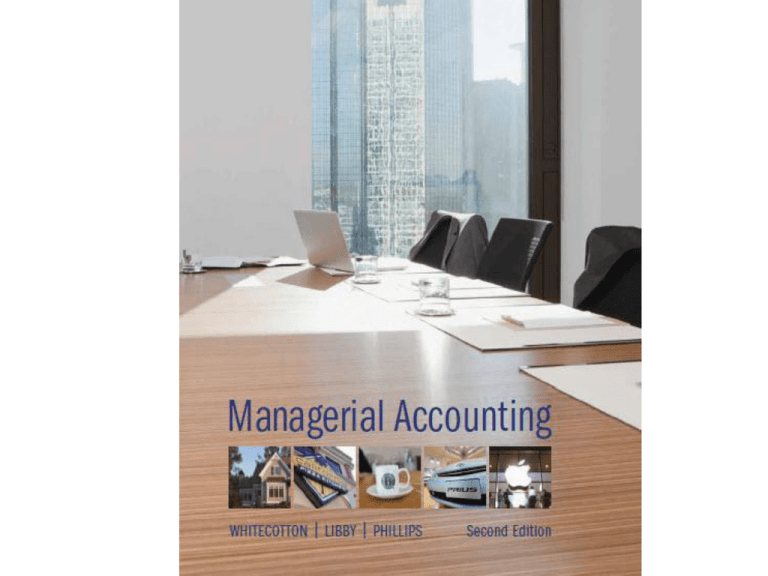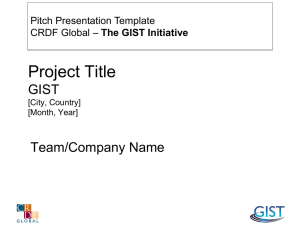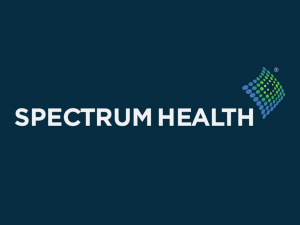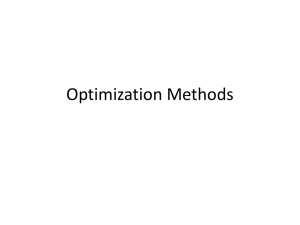
Chapter 6
Cost-Volume-Profit Analysis
PowerPoint Authors:
Susan Coomer Galbreath, Ph.D., CPA
Charles W. Caldwell, D.B.A., CMA
Jon A. Booker, Ph.D., CPA, CIA
Cynthia J. Rooney, Ph.D., CPA
McGraw-Hill/Irwin
Copyright © 2014 by The McGraw-Hill Companies, Inc. All rights reserved.
Assumptions of CVP
6- 3
Cost-Volume-Profit in Graph
A Simplified Example
Only one type and one size of coffee
Price is $2.50 per unit
Variable costs are $1.00 per unit
Fixed costs are $12,000 per month
6- 4
Cost-Volume-Profit in Graph
$80,000
$70,000
Total Revenue
Line
$60,000
$50,000
$40,000
$30,000
Total Cost
Line
Break-Even
Point
$20,000
$10,000
$-
4,000
8,000
12,000
16,000
20,000
Number of Coffee Drinks Served
24,000
28,000
6- 5
Cost-Volume-Profit in Graph
$80,000
$70,000
Total Revenue
Line
$60,000
$50,000
$18,000
Target
Profit
$40,000
$30,000
Total Cost
Line
Break-Even
Point
$20,000
$10,000
Loss
$-
4,000
8,000
12,000
16,000
20,000
Number of Coffee Drinks Served
24,000
28,000
6- 6
Learning Objective 6-1
Use cost-volume-profit analysis to
find the break-even point.
6- 7
Basic CVP Analysis
Break-even analysis is a special case of the
simplest form of cost-volume-profit analysis. The
goal of break-even analysis is to determine the level
of sales (in either units or total sales dollars) needed
to break even, or earn zero profit.
Methods
1. Profit equation method
2. Unit contribution margin method
3. Contribution margin ratio method
6- 8
Profit Equation Approach
Total sales revenue – Total variable costs – Total fixed costs = Profit
(Unit price × Q) – (Unit variable costs × Q) – Total fixed costs = Profit
Q = Quantity of unit sold
6- 9
Profit Equation Approach
To find the break-even point, we simply set the profit equation
equal to zero, and solve for the quantity of units (Q).
Break-Even Analysis
(Unit Price × Q) – (Unit Variable Costs × Q) – Total Fixed Costs = Profit
($2.50 ×Q) – ($1.00 × Q) – $12,000 = 0
$1.50Q = $12,000
Q = $12,000 ÷ $1.50
Q = 8,000
6- 10
Profit Equation Approach
Let’s verify our break-even analysis.
Break-Even Analysis
(Unit Price × Q) – (Unit Variable Costs × Q) – Total Fixed Costs = Profit
($2.50 ×8,000) – ($1.00 × 8,000) – $12,000 = 0
$20,000 – $8,000 – $12,000 = 0
6- 11
Learning Objective 6-2
Use cost-volume-profit analysis to
determine the sales needed to
achieve a target profit.
6- 12
Profit Equation Approach
Assume that the target profit was $18,000.
Target Profit Analysis
(Unit Price × Q) – (Unit Variable Costs × Q) – Total Fixed Costs = Profit
($2.50 × Q) – ($1.00 × Q) – $12,000 = $18,000
1.5Q = $30,000
Q = 20,000 units
6- 13
Unit Contribution Margin Approach
6- 14
Unit Contribution Margin Approach
Compute the breakeven point in units for Starbucks.
Recall that Starbucks’s total fixed costs are $12,000
and the unit contribution margin is $1.50 per cup.
Break-Even
=
Units
Break-Even Units
Break-Even Units
Total Fixed Costs
Unit Contribution Margin
= $12,000 ÷ $1.50 per cup
= 8,000 cups
6- 15
Unit Contribution Margin Approach
To translate break-even units into sales revenue, we
can multiply by the unit sales prices.
Break-Even Sales = Break-Even Units × Unit Sales Price
Break-Even Sales = 8,000 cups × $2.50 = $20,000
6- 16
Unit Contribution Margin Approach
Assume that the target profit was $18,000.
Target Units =
Target Units
Target Units
=
=
Total Fixed Costs + Target Profit
Unit Contribution Margin
($12,000+$18,000) ÷ $1.50 per cup
20,000 cups
6- 17
Contribution Margin Ratio Approach
6- 18
Contribution Margin Ratio Approach
At break-even, the total contribution margin must equal total
fixed costs, with nothing left over as profit.
$12,000 ÷ 60% = Break-Even Sales ($)
$20,000 = Break-Even Sales ($)
6- 19
Contribution Margin Ratio Approach
Assume that the target profit was $18,000.
($30,000 ÷ 60% = Target Sales ($)
$50,000 = Target Sales ($)
6- 20
Learning Objective 6-3
Compute the margin of safety.
6- 21
Margin of Safety
Margin of safety is the difference between actual or
budgeted sales and the break-even point.
6- 22
Margin of Safety
Recall that $20,000
was break-even sales.
Margin of Safety = $37,500 ‒ $20,000 = $17,500
6- 23
Learning Objective 6-4
Analyze how changes in prices and
cost structure affect the costvolume-profit relationship.
6- 24
Changing Prices
Assume Starbucks’s manager is considering increasing the price
of coffee to $4.00, with no effect on unit variable cost or total
fixed costs.
Notice that both the unit contribution margin and the
contribution margin ratio increased as a result of the price
increase.
6- 25
Changing Prices
What sales level will be needed at the new price to earn a target
profit of $10,500?
Contribution Margin Ratio Method
Unit Contribution Margin Method
6- 26
Changing Variable Costs and Volume
Assume Starbucks’s manager is trying to increase profit to $16,800
per month. He plans to purchase higher quality coffee beans which
will raise variable costs by $0.25 per unit and is expected to
increase sales volume by 20%.
What unit price would be needed to earn the target profit?
New Unit Variable Cost: $1.25 ($1.00 + $ 0.25)
New Sales Volume: 18,000 units (15,000 X 120%)
6- 27
Changing Variable Costs and Volume
Profit Equation Method
6- 28
Changing Fixed Costs and Prices
Assume the Starbucks manager is considering starting a customer
appreciation program that would reward customers by giving them
their tenth cup of coffee for free. The company would spend an
additional $3,000 per month to advertise the rewards program.
How much sales volume is needed to earn a target profit of
$16,800?
New Average Price: $2.25
((9 units at $2.50) / 10)
New Fixed Costs: $15,000
($12,000 + $3,000)
6- 29
Changing Fixed Costs and Prices
Unit Contribution Margin Method
6- 30
Changes in Cost Structure
Cost structure refers to how a company uses variable
costs versus fixed costs to perform its operations.
•
•
•
•
Starbucks Example:
Investing in touch screens to allow customers
to place their own order.
Increase fixed costs by $14,000 per
month.
Decrease variable costs per unit by $0.70.
Unit sales price will be unchanged at $2.50.
What level of volume would be needed to
justify this expenditure?
6- 31
Changes in Cost Structure
Instead of setting a single profit equation equal to zero (to find
break-even), we set two profit equations equal to one another, so
that each alternative yields the same profit. Then we solve for the
number of units that will give an equal profit under either alternative.
Profit Equation Method
At a sales volume of 20,000 units, the company will make the
same profit with or without automation.
6- 32
Changes in Cost Structure
Before Automation
Automation increases the breakeven point because fixed costs
are higher. But each unit adds
more profit because of the lower
variable cost per unit.
After Automation
6- 33
Learning Objective 6-5
Calculate the degree of operating
leverage and use it to predict the
effect a change in sales will have on
profit.
6- 34
Degree of Operating Leverage
Degree of operating leverage measures the extent to
fixed costs are used to operate the business.
In general, high fixed costs indicate that a company is
highly leveraged.
6- 35
Degree of Operating Leverage
Let's see how the trade-off of fixed and variable costs (through
automation) affected Starbucks’s degree of operating leverage. We
will use the indifference point of 20,000 cups sold.
6- 36
Degree of Operating Leverage
The degree of operating leverage is a multiplier we can use to predict
how a percentage change in sales revenue will translate into a percentage
change in profit. In this example, if sales revenue increases by 10%, profit
will increase by 16.7% without automation or 24.4% with automation.
6- 37
Learning Objective 6-6
Perform multiproduct cost-volumeprofit analysis and explain how the
product or sales mix affects the
analysis.
6- 38
Multi-Product Cost-Volume-Profit
Analysis
•
Product mix is the relative mix of products or
services stated in terms of the number of units
sold.
The product mix is used to compute the weightedaverage contribution margin per unit.
•
Sales mix is the relative mix of products or
services as a percentage of total sales revenue.
The sales mix is used to compute the weightedaverage contribution margin ratio, or contribution
margin as a percentage of sales.
6- 39
Weighted-Average Contribution Margin
Let’s extend our example by assuming that Starbucks sells
two products: coffee and pastries.
Notice a lower unit contribution margin
for coffee, $1.50, than pastries, $2.75.
6- 40
Weighted-Average Contribution Margin
The management at Starbucks estimates that 60% of units sold
are coffee and 40% pastries. Based on this product mix, we can
calculate the weighted-average unit contribution margin.
6- 41
Break-Even Analysis
6- 42
Target Profit Analysis
Let’s assume that four coffee drinks are served for every one
pastry (or a 4 to 1 ratio). The new product mix is 80% coffee units
and 20% pastry units. Based on this product mix, we can calculate
the weighted-average unit contribution margin.
6- 43
Target Profit Analysis
If the Starbucks manager wants to earn a monthly profit of $9,000
and monthly fixed costs remain at $12,000, how many coffee and
pastry units must be sold?
6- 44
Target Profit Analysis
6- 45
Weighted-Average Contribution
Margin Ratio
We can also do multiproduct CVP analysis
by using the sales mix (stated in terms of
total sales dollars) to compute the
weighted-average contribution margin ratio.
This approach is commonly used in
business because managers often have
aggregated information about revenue
and costs by product line.
6- 46
Weighted-Average Contribution
Margin Ratio
6- 47
Weighted-Average Contribution
Margin Ratio
Assume that the Starbucks’s manager wants to
earn a target profit of $15,000.
6- 48
End of Chapter 6
6- 49










